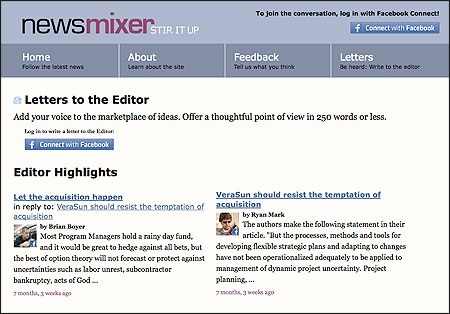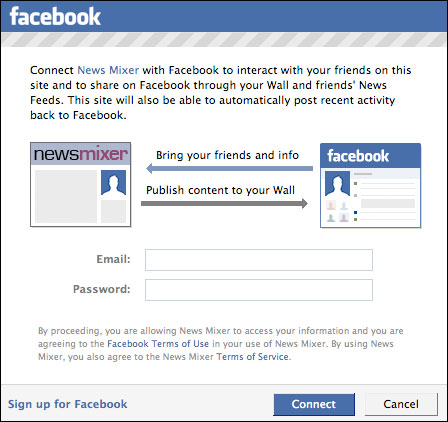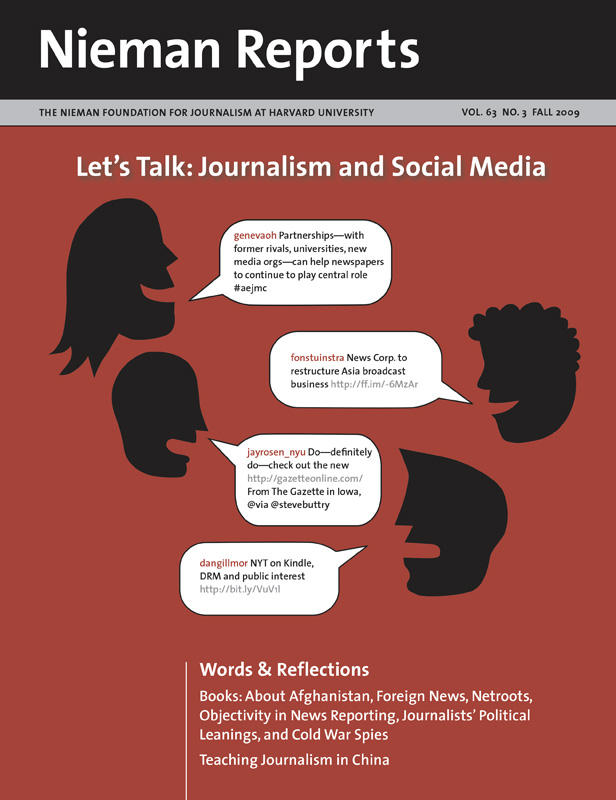
Newsmixer.us was created by graduate students at the Medill School of Journalism at Northwestern University to test new ways for users to comment on news stories.
Richard Gordon also wrote about News Mixer—and the reactions to it—in a post he wrote for the Media Shift Idea Lab.When the history of online journalism is written, it will be hard to ignore the biggest mistake made by news organizations and media companies: thinking of the World Wide Web as primarily a one-way broadcasting or publishing medium.
Back in 1996, when I was the first online director for The Miami Herald Publishing Company, I was as guilty of this misperception as anyone. Our team created discussion boards but hoped they’d require no attention from our staff. We didn’t think that cultivating community or moderating discussions were appropriate or necessary roles for a journalist. And we ignored evidence right in front of us—our own behavior as online users—that the most powerful and persistent driver of Internet usage was the value of connecting with other people.
Today, with commenting opportunities available on almost any kind of content Web site, and with Facebook and Twitter empowering new forms of interpersonal communication online, it’s hard to find a news organization that’s not trying to tap into what we once would have called “online communities” and now more typically refer to as “social media.”
So this may not be the ideal time to suggest that the social media landscape is continuing to be transformed in ways that journalists and news organizations will find confounding. Online communities and social networks, which historically have been formed on Web sites, are instead becoming Web services that shape people’s digital lives across many sites and many communication channels. As online users and consumers, we will likely welcome and appreciate this transformation, but it will create new challenges for journalists, news organizations, and media companies that are only now starting to embrace social media.

Using Facebook Connect, anyone with a Facebook account can log onto newsmixer.us and post questions, answers, quips and letters to the editor.
Facebook and Twitter
The two forces driving the latest evolution of interpersonal communication online are now well known: Facebook and Twitter. Savvy journalists and media leaders recognize how important these sites are, but many have not noticed what I think are their most significant attributes:
Facebook, through a service called Facebook Connect, now allows any other Web site to log in users with their Facebook ID instead of a site-specific login. Beyond that, Facebook Connect allows other sites to shape users’ experiences through profile information, such as their list of Facebook friends.
Twitter, because it makes tweets available through an easily available Application Programming Interface (API), has enabled the creation of an enormous variety of applications that tap into its ever-growing database of 140-character snippets without requiring the user to visit Twitter.com.
Last year, Forrester Research analyst Charlene Li predicted: “… in the future, social networks will be like air.” It will seem “archaic and quaint,” Li wrote, that we had to go to a Web site to “be social.” At the time, it wasn’t easy to find the evidence that Li’s prediction would come true any time soon. But now, changes at Facebook and Twitter are bringing the future more clearly into focus.
Facebook officially launched Facebook Connect in December, after several months in which a few sites were invited to test it. Today, Facebook says more than 15,000 sites have implemented the service, including YouTube, CNN, Digg and Microsoft’s XBox Live service for gamers. While this means online users are becoming accustomed to being offered the option of logging in with their Facebook ID, they might not grasp just how novel this service is by the standards of traditional media thinking.
The revolutionary idea behind Facebook Connect is this: Facebook is encouraging other sites to create more engaging user experiences by leveraging the Facebook “social graph”—without needing to visit Facebook.com. This approach is completely counter to the thinking of traditional news organizations, which have been reluctant even to link to other sites for fear that users will click away and not come back.
Meanwhile, Twitter has become a widely recognized (and sometimes ridiculed) phenomenon not because of Twitter.com, a site experienced through a Web browser, but because of add-ons such as Twhirl and Tweetdeck. This software for personal computers manages people’s Twitter experience, with comparable tools such as Twitterific for users of mobile phones. As with Facebook Connect, Twitter is enabling people to connect without visiting its Web site.
There are other services trying to capitalize on the same basic concepts—such as OpenID, a service enabling log-ins to multiple sites using the same ID, and Friend Connect, Google’s effort to compete with Facebook Connect. Google is also a force in the OpenSocial consortium, which is trying to develop a commonly accepted toolkit for connecting the social Web.

Users write Twitter-style quips and comments, which appear alongside the main story.
News Mixer
I can’t pretend to know how all this will evolve, which social interaction tools will become the most popular, and whether social networks will ever really become “like air” online. But some of the implications are becoming clear:
- Web sites that have built their audiences by enabling user participation have new opportunities to do so by leveraging social networks people have established elsewhere.
- Social network IDs—typically based on real names—might enable higher-quality interaction than we’ve seen on news sites where the identity of those who comment is often shielded by anonymity.
- Content sites may find themselves challenged in growing audience engagement because their users are interacting mostly through their social networks instead of on separate Web sites.
- An increasing amount of content shared on Facebook and Twitter consists of Web links that search engines cannot see or index. This poses for Google the most serious threat yet to achieving its corporate mission: “to organize the world’s information and make it universally accessible and useful.”
- As Facebook and Twitter increase their ability to understand users and their behavior, they could become formidable advertising platforms—competing with original-content sites but also potentially becoming useful partners in selling and delivering targeted advertising on news and media Web sites.
To illustrate some of the opportunities that are presented by the new social landscape, I can point to News Mixer, a Web site prototype developed by a class that I codirected last year (with my colleague Jeremy Gilbert) in the journalism master’s program at the Medill School at Northwestern University.
The six students in the class1—including two software developers who were earning their master’s in journalism through a “programmer-journalist” scholarship program funded by the Knight News Challenge—were asked to come up with approaches to “conversations around news.” They concluded that news site comments often didn’t work well. The quality of conversation was poor, and the vast majority of users rarely participated. They also noted that news sites have applied little creative thinking to the challenge of building user participation. All they’ve done is offer an “open-ended comment box.”
The students designed News Mixer to improve the user experience. First, it uses Facebook Connect, which, of course, means people can log in with their Facebook ID. Beyond that, the site highlights comments from each user’s social network, meaning that every user has a different—and personalized—experience. Also, every time people post to News Mixer, they are given the option of cross-posting that comment to their Facebook feed, exposing it to friends who are not using News Mixer, thereby potentially drawing them to participate as well.
In place of the open-ended comment box, News Mixer offers three ways of commenting:
Questions and Answers: Displayed like annotations in the margin of an article, readers can ask a question about any paragraph of the article—or respond to questions left behind by other people.
Quips: Visible as a small talk-bubble in a live feed on the home page and on article pages, quips are short-form comments that allow people to leave feedback in a quick, to-the-point form. They’re modeled after Twitter and instant messaging.
Letters to the Editor: A very old idea, but with a few new twists. News Mixer calls on letter writers to “add your voice to the marketplace of ideas. Offer a thoughtful point of view in 250 words or less.” Once written, letters are treated equivalently to articles in News Mixer. Each letter gets its own page, and people are allowed to write letters in response. When a letter is particularly insightful, an editor can use the News Mixer content management system to designate it as an “editor highlight.” These then appear on the home page, intermingled with news articles. The idea is to encourage and reward the most thoughtful responses.
News Mixer has been widely praised, described as “an innovative community news framework” (by the influential blog Read/Write Web), a “cool new project” (Editor & Publisher), and “a great piece of innovation” (blogger/consultant Mark Potts). The software code that powers News Mixer has been made available on an open-source basis, and several companies are experimenting with it.
Whatever happens with News Mixer, social media are changing in fundamental ways. Journalists, newsrooms and media companies ignore these changes at their peril.
Richard Gordon is an associate professor and director of digital innovation at Medill School of Journalism at Northwestern University.



